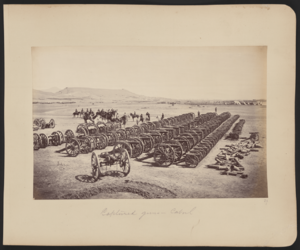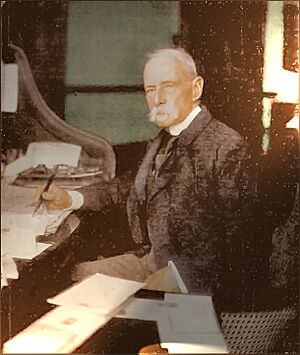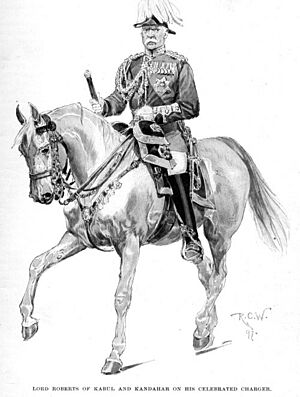Frederick Roberts, 1st Earl Roberts facts for kids
Quick facts for kids
The Earl Roberts
|
|
|---|---|
 |
|
| Birth name | Frederick Sleigh Roberts |
| Nickname(s) | Bobs |
| Born | 30 September 1832 Cawnpore, British India |
| Died | 14 November 1914 (aged 82) St Omer, France |
| Buried |
St Paul's Cathedral, London
|
| Allegiance | British Empire |
| Service/ |
Bengal Army British Army |
| Years of service | 1851–1904 |
| Rank | Field Marshal |
| Unit | Royal Artillery |
| Commands held | Commander-in-Chief of the Forces Command of British troops in Second Boer War until 1900 Commander-in-Chief, Ireland Commander-in-Chief, India Commander-in-Chief in Madras Governor of Natal Kabul and Kandahar Field Force Kabul Field Force Kurram Valley Field Force |
| Battles/wars | Indian Rebellion
Umbeyla Campaign Lushai Expedition
|
| Awards | Victoria Cross Knight of the Order of the Garter Knight of the Order of St Patrick Knight Grand Cross of the Order of the Bath Member of the Order of Merit Knight Grand Commander of the Order of the Star of India Knight Grand Commander of the Order of the Indian Empire Knight of the Order of St John Mentioned in Despatches |
| Relations | Frederick Roberts (son) Sir Abraham Roberts (father) |
| Signature | |
Field Marshal Frederick Sleigh Roberts, also known as Earl Roberts, was a very successful British military leader. He lived from 1832 to 1914. Born in British India, Roberts joined the army and became famous during the Indian Rebellion of 1857. He even won the Victoria Cross for his bravery.
Later, he fought in the Abyssinian and Second Anglo-Afghan Wars. His achievements made him a well-known figure. He became the Commander-in-Chief, India, and then led British forces during the Second Boer War. He was also the last Commander-in-Chief of the Forces before that role ended in 1904.
Roberts was a short man, but his troops and the public loved him. They called him "Bobs." He was seen as a symbol of the British Army when the British Empire was at its strongest. In his later years, he strongly believed Britain needed a stronger military. This was because of the growing threat from Germany before World War I.
Contents
Early Life and Education
Frederick Sleigh Roberts was born in Cawnpore, India, on September 30, 1832. His father, Sir Abraham Roberts, was a general from an Anglo-Irish family in Ireland. His mother was Isabella Bunbury.
Roberts went to famous schools like Eton, Sandhurst, and Addiscombe Military Seminary. In 1851, he joined the East India Company Army as a second lieutenant in the Bengal Artillery. He became a lieutenant in 1857.
Fighting in the Indian Rebellion
Roberts fought in the Indian Rebellion of 1857. He was part of the siege and capture of Delhi, where he was slightly hurt. He also helped during the relief of Lucknow.
For his brave actions on January 2, 1858, at Khudaganj, he was given the Victoria Cross. This is the highest award for bravery in the British military. Later that year, he moved from the East India Company Army to the British Indian Army.
Campaigns in Abyssinia and Afghanistan
Roberts continued to rise through the ranks. He fought in the Umbeyla campaign in 1863 and the Abyssinian campaign in 1867–1868. He also took part in the Lushai campaign from 1871 to 1872.
In 1878, he led the Kurram Valley Field Force in the Second Anglo-Afghan War. He won an important victory at the Battle of Peiwar Kotal in December 1878. For this, he was promoted to major general.
After a British official was killed in Kabul in 1879, Roberts was sent to take control. He won the Battle of Charasiab and occupied Kabul. His forces were then surrounded in the Sherpur Cantonment but he fought off a large attack.
Later, after a British defeat near Kandahar, Roberts led 10,000 troops on a 300-mile march to relieve the city. He defeated the enemy at the Battle of Kandahar on September 1, 1880. This made him even more famous.
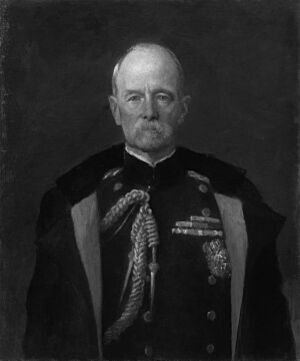
After a short time as Governor of Natal, Roberts became the Commander-in-Chief of the Madras Army in 1881. In 1885, he became Commander-in-Chief, India. He was promoted to general in 1890 and became Baron Roberts in 1892.
Time in Ireland
After his time in India, Roberts moved to Ireland. From 1895, he was the Commander-in-Chief of British forces there. He was promoted to field marshal in 1895.
While in Ireland, Roberts wrote a book about his years in India. It was called Forty-one Years in India: from Subaltern to Commander-in-chief and was published in 1897.
Leading in the Second Boer War
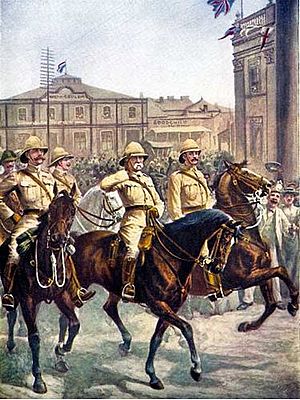
In December 1899, Roberts went to South Africa to take command of British forces in the Second Boer War. He arrived in Cape Town in January 1900. He was sent because the British had suffered some defeats early in the war.
Roberts launched a major attack. He personally led his troops into the Orange Free State. During this time, his son was killed in battle, and he was awarded a Victoria Cross after his death.
Roberts' forces freed the city of Kimberley. At the Battle of Paardeberg in February 1900, he forced the Boer General Piet Cronjé to surrender with about 4,000 men. After another win at Poplar Grove, Roberts captured the Free State capital, Bloemfontein, in March.
His advance was slowed by problems with army supplies, which led to a serious typhoid outbreak. This disease caused more losses for the British than fighting did.
In May, Roberts continued his attack towards the Transvaal. He captured its capital, Pretoria, on May 31. He won his last battle at Bergendal in August.
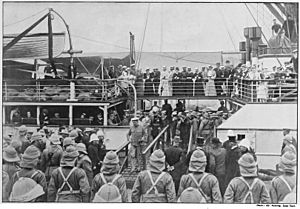
To try and end the war, Roberts used strategies that included setting up concentration camps and burning farms. The conditions in these camps became very bad. There wasn't enough space, food, clean water, or medicine. This led to many women and children dying from disease. By the end of the war, over 26,000 women and children died in these camps.
On December 12, 1900, Roberts handed over command to Lord Kitchener. Roberts returned to England and received many honors. He was made a Knight of the Order of the Garter and became Earl Roberts.
Later Life and Legacy
Lord Roberts became the last Commander-in-Chief of the Forces in 1901. During his time, he improved weapons and training for soldiers. He held this position for three years until the role was ended in 1904.
Supporting Military Training
After the Boer War, Roberts strongly supported training civilians in rifle shooting. He believed this would help prepare Britain for a major war in Europe. He campaigned for compulsory military training as president of the National Service League from 1905 to 1914. He even helped a writer with a novel about an invasion of Britain.
In a speech in Manchester in 1912, Roberts warned about the growing threat from Germany. This speech caused a lot of discussion and was criticized by some newspapers. However, many historians later said he was right to warn the country.
Skiing and Other Interests
Roberts was also involved in sports. He became vice-president of the Public Schools Alpine Sports Club in 1903. In 1911, the Roberts of Kandahar Challenge Cup ski race was organized. Roberts donated the trophy cup. This race was an important part of skiing history and led to the naming of the Kandahar Ski Club. The name Kandahar is still used for major ski races today.
He also took part in the funerals of Queen Victoria in 1901 and King Edward VII in 1910.
Death and Burial
Lord Roberts died of pneumonia on November 14, 1914, in France. He was visiting Indian troops who were fighting in World War I. His body was brought back to England. After lying in state in Westminster Hall, he was given a state funeral. He was then buried in St Paul's Cathedral in London. He was one of only two non-royals in the 20th century to lie in state in Westminster Hall.
Honors and Recognition
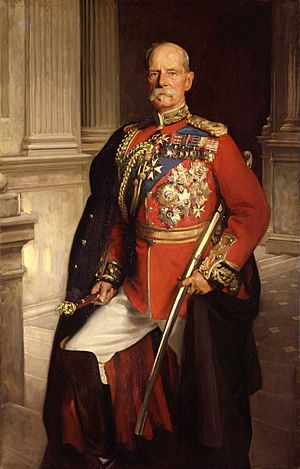
Lord Roberts received many honors throughout his life. He was given the Volunteer Decoration in 1908. He also held many honorary military positions, such as colonel of the Irish Guards.
He received special honors from many cities and universities across Britain. For example, he was given the "Freedom of the City" in places like Cardiff, Portsmouth, Canterbury, and Liverpool.
In 1893, he became an Honorary Fellow of the Royal Scottish Geographical Society.
Family Life
Roberts married Nora Henrietta Bews in 1859. They had six children, but only three survived past infancy: Aileen Mary, Frederick Hugh Sherston, and Ada Edwina Stewart.
Roberts' son, Frederick Hugh Sherston Roberts, was killed in action during the Boer War in 1899. He was also awarded the Victoria Cross after his death. Roberts and his son are one of only three father-son pairs to both receive the Victoria Cross. Their Victoria Cross medals are now in the National Army Museum.
After Roberts' death, his title of Baron ended. However, his elder surviving daughter, Aileen, inherited his titles of Earl and Viscount. After her, her younger sister, Edwina, inherited them.
Lasting Impact
In 1898, a statue of Lord Roberts on horseback was unveiled in Calcutta, India. After his death in 1914, a copy of this statue was placed in Kelvingrove Park, Glasgow, as a memorial. Another, simpler copy was put up on Horse Guards Parade in London in 1924.
Several places are named after him, including Roberts Barracks in England and the town of Robertsganj in India. Schools in Canada, like Lord Roberts French Immersion Public School in London, Ontario, are also named in his honor.
The Lord Roberts Centre, a facility at the National Shooting Centre, is named after him. He was very important in setting up the National Smallbore Rifle Association.
A military town in South Africa, originally called Roberts Heights, was named after him when he set up his headquarters there in 1900. It is now called Thaba Tshwane. Also, an island near the Victoria Falls was named Kandahar Island in his honor.
The grave of his horse, Vonolel, is marked by a headstone in the gardens of The Royal Hospital Kilmainham in Dublin.
Images for kids
See also
 In Spanish: Frederick Roberts para niños
In Spanish: Frederick Roberts para niños



